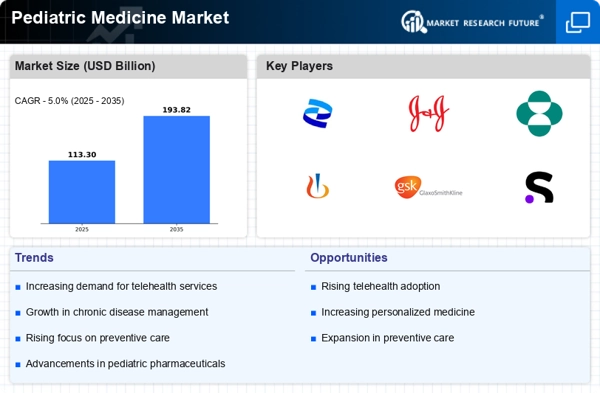Rising Incidence of Pediatric Diseases
The Pediatric Medicine Market is experiencing a notable increase in the incidence of various pediatric diseases, including respiratory infections, allergies, and chronic conditions such as asthma and diabetes. According to recent data, the prevalence of childhood obesity has reached alarming levels, with approximately 18% of children classified as obese. This trend necessitates a greater demand for specialized pediatric treatments and medications. As healthcare providers focus on addressing these rising health concerns, the Pediatric Medicine Market is likely to expand, driven by the need for innovative therapies and preventive measures. Furthermore, the increasing awareness among parents regarding children's health issues is propelling the demand for pediatric healthcare services, thereby influencing market growth.
Advancements in Pediatric Pharmaceuticals
Innovations in pediatric pharmaceuticals are significantly shaping the Pediatric Medicine Market. The development of age-appropriate formulations, such as liquid medications and chewable tablets, caters specifically to the unique needs of children. Recent advancements in drug delivery systems, including transdermal patches and inhalers designed for pediatric use, enhance treatment efficacy and adherence. The market for pediatric pharmaceuticals is projected to grow at a compound annual growth rate (CAGR) of approximately 7% over the next few years. This growth is driven by the increasing investment in research and development aimed at creating safer and more effective medications for children. As pharmaceutical companies prioritize pediatric formulations, the Pediatric Medicine Market is poised for substantial expansion.
Increased Investment in Pediatric Research
Increased investment in pediatric research is emerging as a significant driver for the Pediatric Medicine Market. Funding from both public and private sectors is being directed towards understanding pediatric diseases and developing targeted therapies. Research initiatives focusing on genetic disorders, rare diseases, and chronic conditions affecting children are gaining momentum. This influx of funding is likely to accelerate the discovery of new treatments and medications tailored for pediatric patients. As a result, the Pediatric Medicine Market may witness a surge in innovative products entering the market, addressing unmet medical needs. The commitment to advancing pediatric research not only enhances treatment options but also fosters collaboration among healthcare professionals, researchers, and pharmaceutical companies, further propelling market growth.
Growing Awareness of Pediatric Health Issues
There is a growing awareness of pediatric health issues among parents and caregivers, which is positively impacting the Pediatric Medicine Market. Educational campaigns and initiatives by healthcare organizations are informing families about the importance of regular health check-ups and vaccinations. This heightened awareness is leading to increased visits to pediatricians and healthcare facilities, thereby driving demand for pediatric medicines. Recent statistics indicate that routine immunization coverage for children has improved, with over 90% of children receiving essential vaccines. As parents become more proactive in managing their children's health, the Pediatric Medicine Market is likely to benefit from this trend, resulting in increased sales of vaccines and other preventive medications.
Expansion of Pediatric Healthcare Infrastructure
The expansion of pediatric healthcare infrastructure is a critical driver for the Pediatric Medicine Market. Governments and private entities are investing in the establishment of specialized pediatric hospitals and clinics to cater to the growing needs of children. This expansion is particularly evident in underserved regions, where access to pediatric care has historically been limited. The establishment of dedicated pediatric units within general hospitals is also on the rise, enhancing the availability of specialized care. As healthcare systems evolve to accommodate the unique needs of children, the Pediatric Medicine Market is expected to experience growth, driven by increased access to pediatric services and medications. This trend may lead to improved health outcomes for children and a corresponding rise in demand for pediatric pharmaceuticals.


















Leave a Comment